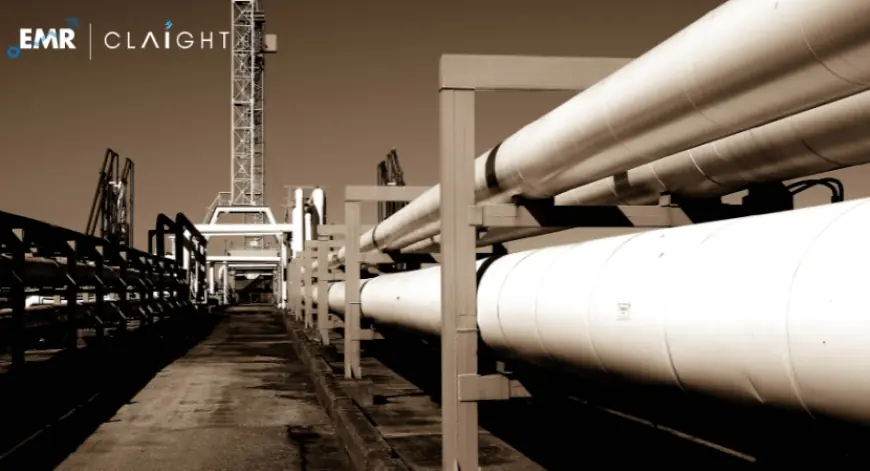Onshore Oil and Gas Pipeline Market Size & Industry Share | Forecast 2034
Onshore oil and gas pipelines are transportation systems used to convey hydrocarbons from extraction points to processing facilities or storage locations.

Onshore Oil and Gas Pipeline Market Outlook
The global onshore oil and gas pipeline market is poised for substantial growth during the forecast period from 2025 to 2034, with an expected Compound Annual Growth Rate (CAGR) of 5.4%. This growth is primarily driven by increasing energy demand, the need for efficient transportation of hydrocarbons, and advancements in pipeline technologies. Onshore pipelines play a crucial role in connecting oil and gas production sites with refineries, distribution centers, and end-users, making them integral to the global energy supply chain.
Definition and Importance of Onshore Pipelines
Onshore oil and gas pipelines are transportation systems used to convey hydrocarbons from extraction points to processing facilities or storage locations. They are typically constructed of steel or plastic and designed to withstand various environmental conditions. The efficiency, safety, and reliability of these pipelines are critical, given the potential environmental impacts of oil and gas spills.
Get a Free Sample Report with Table of Contents@https://www.expertmarketresearch.com/reports/onshore-oil-and-gas-pipeline-market/requestsample
Market Dynamics
Key Drivers
-
Growing Energy Demand: The global demand for energy continues to rise, driven by population growth, urbanization, and industrialization. This trend necessitates the expansion and modernization of oil and gas transportation infrastructure.
-
Technological Advancements: Innovations in pipeline construction, monitoring, and maintenance technologies are enhancing the safety and efficiency of onshore pipelines. Advanced sensors, drones, and predictive maintenance systems are examples of technologies that improve operational reliability.
-
Regulatory Support: Governments worldwide are recognizing the importance of energy infrastructure for economic growth. Supportive regulations and policies aimed at promoting safe and efficient pipeline construction are expected to bolster market growth.
Challenges
-
Environmental Concerns: The potential for environmental disasters resulting from pipeline leaks or ruptures poses significant challenges. Increasing scrutiny from regulatory bodies and public opposition can hinder pipeline projects.
-
Geopolitical Risks: The oil and gas industry is sensitive to geopolitical tensions that can affect supply chains and investment decisions. Political instability in key oil-producing regions can disrupt pipeline operations.
-
Market Volatility: Fluctuations in oil and gas prices can impact the financial viability of pipeline projects. Companies may delay investments in new infrastructure during periods of low prices.
Market Segmentation
The global onshore oil and gas pipeline market can be segmented based on the following criteria:
By Material Type
- Steel Pipelines: Dominating the market due to their strength and durability, steel pipelines are widely used for transporting high-pressure fluids.
- Plastic Pipelines: Gaining traction due to their resistance to corrosion and lower installation costs, plastic pipelines are increasingly used for certain applications.
By Application
- Crude Oil Transportation: This segment is the largest, driven by the need to transport crude oil from production sites to refineries.
- Natural Gas Transportation: The demand for natural gas pipelines is increasing due to the shift towards cleaner energy sources.
By Region
- North America: A significant market due to extensive oil and gas reserves, with the U.S. and Canada leading in pipeline development.
- Europe: Driven by regulatory support for energy infrastructure and diversification of energy sources.
- Asia-Pacific: Expected to witness the highest growth, driven by increasing energy demand and investments in pipeline projects.
Competitive Landscape
The onshore oil and gas pipeline market is characterized by the presence of several key players, including:
1. Arcelor Mittal S.A.
A global leader in steel manufacturing, Arcelor Mittal is actively involved in providing high-quality steel products for pipeline construction. Their expertise in material science and commitment to sustainability position them as a significant player in the pipeline market.
2. Tenaris S.A.
Tenaris specializes in steel pipes for the energy industry, offering a range of products designed for various pipeline applications. Their focus on innovation and technology helps improve the efficiency and safety of pipeline systems.
3. CPW America Co.
CPW America is recognized for its comprehensive pipeline solutions, including manufacturing and engineering services. Their commitment to quality and customer service makes them a valuable player in the pipeline sector.
4. Essar Group
With a diverse portfolio in the energy sector, Essar Group is involved in the construction and operation of pipelines. Their experience in large-scale projects enhances their competitiveness in the market.
5. TMK Group
TMK is a leading manufacturer of pipes for the oil and gas industry, known for its advanced production technologies and strong global presence. Their innovative products cater to the growing needs of the pipeline market.
6. Others
Numerous other companies contribute to the market, including regional players and specialized firms focusing on specific aspects of pipeline construction, maintenance, and technology.
Regional Analysis
North America
North America is a dominant player in the onshore oil and gas pipeline market, primarily due to its vast reserves of oil and natural gas. The United States, in particular, has a well-developed pipeline infrastructure that facilitates the transportation of hydrocarbons from production areas to processing facilities. The shale boom has further increased the demand for pipelines, driving investments in both new construction and upgrades to existing systems.
Europe
In Europe, the onshore pipeline market is driven by the need for energy diversification and regulatory compliance. The European Union's push for cleaner energy sources has led to investments in natural gas pipelines and infrastructure for renewable energy. Countries like Germany, France, and the UK are focusing on enhancing their pipeline networks to ensure energy security and reduce reliance on external sources.
Asia-Pacific
The Asia-Pacific region is expected to experience the highest growth in the onshore oil and gas pipeline market. Countries such as China and India are investing heavily in energy infrastructure to meet rising demand. The increasing focus on natural gas as a cleaner alternative to coal is driving the construction of new pipelines, particularly in urban areas.
Latin America and Middle East Africa
These regions are also witnessing growth in the onshore pipeline market, albeit at a slower pace compared to North America and Asia-Pacific. In Latin America, countries like Brazil and Colombia are developing their pipeline infrastructure to support oil and gas exploration. In the Middle East and Africa, ongoing investments in energy projects are expected to drive demand for onshore pipelines.
Future Trends and Opportunities
Investment in Infrastructure
The onshore oil and gas pipeline market is set to benefit from increased investments in energy infrastructure. Governments and private companies are recognizing the need for modernization and expansion of pipeline networks to meet future energy demands.
Focus on Sustainability
With growing concerns about environmental impact, there is a shift towards more sustainable practices in pipeline construction and operation. Companies are investing in technologies that minimize leaks and reduce carbon footprints, ensuring compliance with environmental regulations.
Digital Transformation
The integration of digital technologies in pipeline management is expected to revolutionize the industry. Advanced monitoring systems using IoT, AI, and big data analytics will enhance operational efficiency and safety, enabling real-time decision-making.
Expansion into Emerging Markets
As energy demand continues to rise in emerging markets, companies are looking to expand their footprint in regions with untapped potential. Strategic partnerships and investments in local infrastructure will be critical to capturing growth opportunities.
Media Contact:
Company Name: Claight Corporation
Contact Person: Eren smith, Corporate Sales Specialist – U.S.A.
Email: sales@expertmarketresearch.com
Toll Free Number: +1-415-325-5166 | +44-702-402-5790
Address: 30 North Gould Street, Sheridan, WY 82801, USA
Website: https://www.expertmarketresearch.com
Tags:
What's Your Reaction?
 Like
0
Like
0
 Dislike
0
Dislike
0
 Love
0
Love
0
 Funny
0
Funny
0
 Angry
0
Angry
0
 Sad
0
Sad
0
 Wow
0
Wow
0



















































